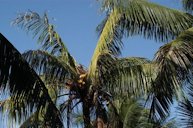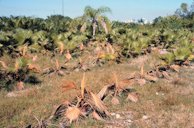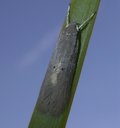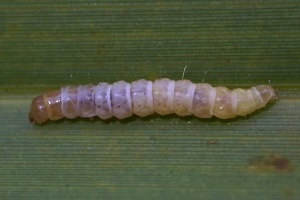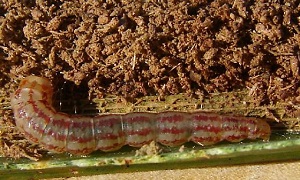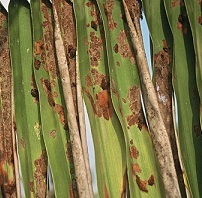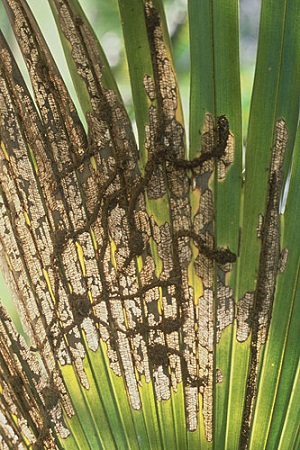| California Fan Palm - Pests and Diseases | |||||||||||||||
|---|---|---|---|---|---|---|---|---|---|---|---|---|---|---|---|
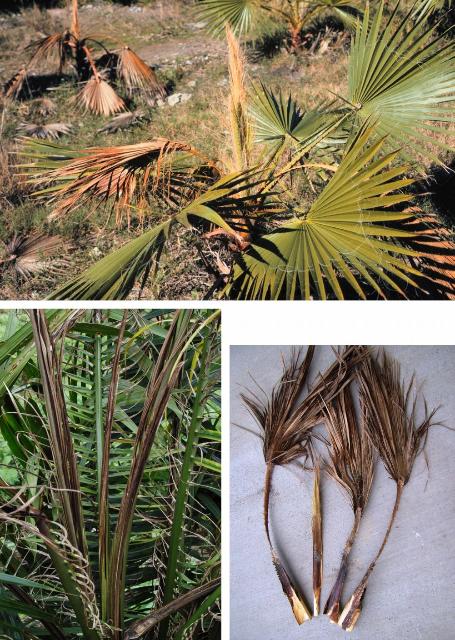 Fig. 1  Spear leaf and next youngest leaf exhibiting typical symptoms of phytopthora bud rot 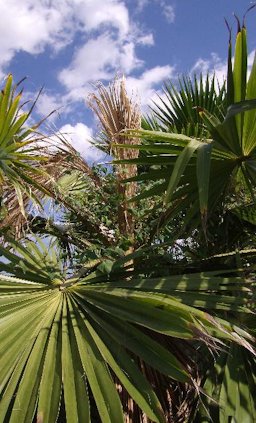 Fig. 2
Fig. 2  W. robusta exhibiting typical bud rot symptoms. Only the spear leaf and next youngest leaf are affected by the pathogen; older leaves remain healthy. 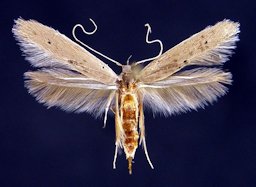 Fig. 5  Palm leaf skeletonizer adult 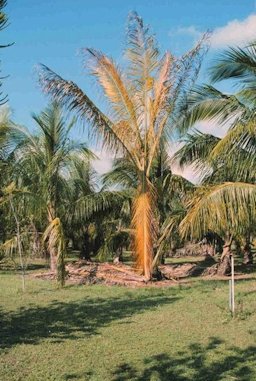 Fig. 11  Foliar yellowing symptoms of lethal yellowing on Caryota rumphiana Back to California Fan Palm |
Phytopthora Bud Rot Caused by the pathogen Phytophthora palmivora The most common bud rot pathogen in Florida is Phytophthora palmivora. Thielaviopsis paradoxa may cause this disease also. The first symptom is discoloration and wilting of the spear leaf and wilting/discoloration of the next youngest leaf. If severe, the spear leaf easily pulls from the bud. In palms with a canopy above eye level, this first symptom is often missed. Instead, a lack of new leaves and an open-topped crown are often the first symptoms to be observed. Because the bud is dead, no new leaves emerge. Older leaves remain healthy for months after the bud dies. Bud rot is also observed in association with cold damage. Cold damage allows entry of secondary pathogens, both fungi and bacteria.1 In general, severely diseased plants should be removed and destroyed immediately to limit pathogen spread. Potting mix from diseased container palms should be removed from the nursery. For mature palms, the diseased palm should be removed and the canopy region (including the bud) destroyed. The lower trunk should be pathogen free, so it would be acceptable to chip it and recycle it in the landscape.1
Fig. 3. Bud rot of Cocos nucifera: no new leaves are emerging and crown is open-topped, while older leaves in canopy look healthy at this time. Fig. 4. Multiple Washingtonia. robusta in this field nursery are being affected by Phytophthora bud rot. Those most affected were juvenile palms in a low-lying area. Further Reading Bud Rot of Palm, University of Florida pdf Palm Leaf Skeletonizer Homaledra sabalella (Chambers) Symptoms appear on mid-canopy to older leaves as necrotic translucent blotches on the leaflets. Often only the epidermal layers of the leaves remain, hence the name "leaf skeletonizer" 2 Caterpillars feed on the upper and lower leaf surfaces, producing large quantities of "frass" that is often the first conspicuous sign of infestation. Tissue between the leaf veins is usually the preferred food, whereby the veins remain intact giving the leaf a skeltetonized appearance. In Florida, larvae are present throughout the year and complete five generations per year in northern Florida. 3
Fig. 6. Adult Fig. 7. Early instar larva Fig. 8. Late instar larva Fig. 9. Palm leaf skeletonizer damage to C. nucifera (pinnate palm) Fig. 10. Damage to W. robusta (palmate palm) Further Reading Palm Leaf Skeletonizer, University of Florida, Okeechobee Extension pdf Leathal Yellowing (Fig.11) Caused by a tiny organism called a phytoplasma This palm is also susceptible to lethal yellowing disease and should not be planted where other palms are suffering from this always fatal disease. Lethal yellowing (LY) is a systemic disease caused by a phytoplasma transmitted by a planthopper. Historically, LY has occurred only in the southern one-third of Florida. The disease was observed for the first time in Sarasota and Manatee Counties on the west coast of Florida in 2007 and in Indian River County on the east coast in 2012. LY symptoms are highly variable among Cocos nucifera (coconut) cultivars and among other palm genera. Palms with greater than 25% leaf discoloration or a dead apical meristem (bud) due to LY should be removed. Management of LY includes trunk injections of oxytetracycline HCl (OTC) every four months, and planting of palm species that are not hosts of LY. Very few palm species native to Florida and the Caribbean Basin appear to be susceptible to LY. 4 Another palm disease caused by a phytoplasma that is similar to, but genetically distinct from, the LY phytoplasma was observed in 2007 on Phoenix canariensis, P. dactylifera and P. sylvestris growing in the south-central coastal region of west Florida (Sarasota to Tampa). The symptoms and management of this disease, called lethal bronzing disease (LBD), formerly Texas Phoenix Palm Decline, on Phoenix species appear to be the same as those for LY. 4 Further Reading Lethal Yellowing (LY) of Palm, University of Florida pdf Lethal Bronzing Disease (LBD), University of Florida pdf Further Reading Normal "Abnormalities" in Palms, University of Florida Cold Damage on Palms, University of Florida pdf |
||||||||||||||
|
Bibliography 1 Elliott, Monica L. "Bud Rot of Palm." Plant Pathology Dept., UF/IFAS Extension, PP-54, Original Pub. Jan. 2006, Rev. Oct. 2015, Reviewed 30 Nov. 2021, AskIFAS, edis.ifas.ufl.edu/pp144. Accessed 1 May 2014, 14 Mar. 2019, 17 Mar. 2024. 2 Anderson, P. J. "Palm Leaf Skeletonizer." Screening Aid to Pests, A Resource for Pests and Diseases of Cultivated Palms. Florida Department of Agriculture and Consumer Service, Division of Plant Industry and Identification Technology Program, CPHST, PPQ, APHIS, USDA; Fort Collins, CO. 2011,itp.lucidcentral.org/id/palms/resource/index.html. Accessed 26 Apr. 2014. 3 Redford, A. J., T. W. Walters, A. C. Hodges, F.W. Howard, and M.D. Trice. "Palm Leaf Skeletonizer." Screening Aid to Pests, A Resource for Pests and Diseases of Cultivated Palms, Identification Technology Program, CPHST, PPQ, APHIS, USDA; Fort Collins, CO. 2010, itp.lucidcentral.org/id/palms/resource/index.html. Accessed 26 Apr. 2014. 4 Bahder, Brian W., and Ericka E. Helmick. "Lethal Yellowing (LY) of Palm." Plant Pathology Dept., UF/IFAS Extension, PP-222, Original Pub. Oct. 2005, Rev. Aug. 2007, Aug. 2009, Aug. 2012, Oct. 2015, and Nov. 2018, Reviewed 30 Aug. 2021, AskIFAS, edis.ifas.ufl.edu/pp146. Accessed 14 Mar. 2019, 17 Mar. 2024. Photographs Fig. 1 Broschat, T. K. and Elliott, M. L. "Bud Rot of Palms." UF/IFAS, edis.ifas.ufl.edu. Accessed 23 Apr. 2014. Fig.2,3 Elliott, M. L. "Bud Rot of Palms." UF/IFAS, edis.ifas.ufl.edu. Accessed 23 Apr. 2014. Fig. 4 Broschat, T. K. "Bud Rot of Palms." UF/IFAS, edis.ifas.ufl.edu. Accessed 23 Apr. 2014. Fig. 5 Vargo, Jim. "Palm Leaf Skeletonizer." Screening Aid to Pests, A Resource for Pests and Diseases of Cultivated Palms, 2010, itp.lucidcentral.org/id/palms/resource/index.html. Accessed 26 Apr. 2014. Fig.6,7 Hollenbeck, Jeff. "Palm Leaf Skeletonizer." Screening Aid to Pests, A Resource for Pests and Diseases of Cultivated Palms, 2010, itp.lucidcentral.org/id/palms/resource/index.html. Accessed 26 Apr. 2014. Fig.8 White, Machele. "Palm Leaf Skeletonizer." Screening Aid to Pests, A Resource for Pests and Diseases of Cultivated Palms, 2010, itp.lucidcentral.org/id/palms/resource/index.html. Accessed 26 Apr. 2014. Fig. 9,10 Howard, F. W. "Palm Leaf Skeletonizer." Screening Aid to Pests, A Resource for Pests and Diseases of Cultivated Palms, 2010, itp.lucidcentral.org/id/palms/resource/index.html. Accessed 26 Apr. 2014. Fig. 11 Harrison, N. A. "Lethal Yellowing." Screening Aid to Pests, A Resource for Pests and Diseases of Cultivated Palms. Florida Department of Agriculture and Consumer Service, Division of Plant Industry and Identification Technology Program, CPHST, PPQ, APHIS, USDA; Fort Collins, CO., 2011, itp.lucidcentral.org/id/palms/resource/index.html. Accessed 30 Apr. 2014. Published 12 Apr. 2014 LR. Last update 19 Mar. 2024 LR |
|||||||||||||||
